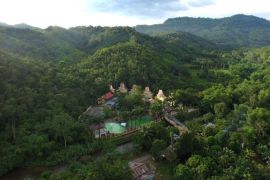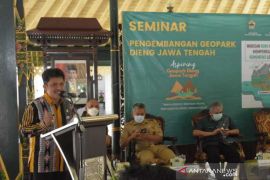The so-called 'revenge tourism' after people were 'imprisoned' for a long time at home due to the COVID-19 pandemic has the potential to increase tourism, especially nature tourism, with the potential for young domestic tourists dominating the earlyBanjarmasin, S Kalimantan (ANTARA) - It certainly comes as good news for Indonesia, with four of its national geoparks having received the green light for endorsement as new UNESCO Global Geoparks (UGGp).
The UGGp Council, at its meeting in September 2022, proposed seven geoparks from six countries, including Ijen in East Java and Maros-Pangkep in South Sulawesi, for endorsement during the 2023 Spring Session.
Thereafter, in December, it proposed 11 other geoparks, including two from Indonesia: Raja Ampat in West Papua and Merangin in Jambi.
This good news should be viewed as an opportunity for Indonesia.
With the government currently promoting the tourism sector as one of the main drivers of the country's economic recovery, geoparks that offer the beauty of nature, culture, and geoheritage are expected to increase tourist visits.
"The so-called 'revenge tourism' after people were 'imprisoned' for a long time at home due to the COVID-19 pandemic has the potential to increase tourism, especially nature tourism, with the potential for young domestic tourists dominating the early recovery of tourism," National Geopark Strategic Development coordinator Togu Pardede remarked.
Indonesia has focused on 10 priority destinations in tourism development: Lake Toba, Borobudur, Mandalika, Labuan Bajo, Likupang, Wakatobi, Raja Ampat, Bangka Belitung, Bromo, and Morotai.
Related news: Cherish the past, embrace the future in Belangian
However, foreign exchange earnings from tourism are relatively low as compared to other Asian countries. In 2020, the figure was recorded at US$19.2 billion, as compared to Thailand, at US$58.1 billion, and Vietnam, at US$28.5 billion.
Pardede said, development of geoparks as tourist destinations that concurrently also preserves the environment and culture has become a solution in conducting sustainable development.
“President Joko Widodo has put in priority the development of tourism in the 2020-2024 medium-term development plans," he remarked.
Development of geoparks as a media for the conservation of nature and culture as well as education aligns with the Sustainable Development Goals (SDGs), he reiterated.
It has contributed to 11 out of the 17 goals in SDGs and involved the partnerships of both the government and non-government actors.
A geopark is an area where sites and landscapes of geological significance are managed with a holistic concept of protection, education, and sustainable development.
Related news: Oldest coal mine in South Kalimantan to become geotourism site
This concept has the potential to become an initial trigger for economic recovery that absorbs labor and has a multiplier effect for other sectors.
Pardede said, geopark development is aimed at changing the mindset in the management of natural resources, from extraction to conservation, that focuses on the improvement of added values.
"Nowadays, we can get the economic value without exploitation. The higher the economic value, the better we maintain it. This is different with the exploitation in the past. Now, conservation is the key," he noted.
Target of 12 UGGp
A geopark stimulates economic activity and sustainable development through geotourism, according to the UNESCO.
By attracting increasing numbers of visitors, it stimulates local socio-economic development through the promotion of a quality label linked with the local natural heritage.
It encourages the creation of local enterprises and cottage industries involved in geotourism and geoproducts.
Currently, Indonesia has 19 national geoparks, six of which have international status (UGGp): Batur, Gunungsewu, Rinjani, Ciletuh-Palabuhanratu, Toba Caldera, and Belitong.
Some 13 others are national geoparks, four of which are proposed by the UGGp Council for endorsement as UGGp in 2023.
Two national geoparks -- Meratus in South Kalimantan and Karangbolong-Karangsambung in Central Java -- has been designated as aspiring UGGp and are preparing for submission to UNESCO to become UGGp.
Indonesia is targeted to have 12 UNESCO Global Geoparks by 2024.
The target is to get six million tourists to visit geosites, a small figure as compared to the number of tourists visiting geoparks in other countries.
Managing Chief of the Indonesian National Commission for UNESCO (KNIU) Itje Chodidjah said the country is committed to preserving geosites and use its wealth to promote Indonesia's world-class sustainable tourism.
All parties should work hand-in-hand to promote its development and preserve the cultural, biological, and geological diversity to achieve the sustainable development goals and reform national education, she stated.
Chodidjah said, the geopark would be able to encourage development in education and tourism in addition to providing jobs for local people through the use of local culture and products while accentuating conservation.
Related news: UNESCO assessors to visit Meratus Geopark in South Kalimantan
"The key in determining the success of geopark development is good management. I hope that all elements of the nation can be parts of the campaign to conserve geopark. Local people should take part in environment preservation and explore the tourism potential. Hence, it can bring benefits to the people's welfare," President Joko Widodo stated.
Deputy for Tourism and Creative Economy at the Coordinating Ministry for Maritime and Investment Affairs Odo R.M. Manuhutu said, the development of geoparks, as sustainable tourist destinations in Indonesia, had yet to be conducted optimally.
Among the problems faced is limited funding.
However, he said, the government could collaborate with the media, business actors, and education and volunteer groups in various sectors.
"Partnership scheme can become an alternative of funding in geopark management," he remarked.
He cited the example of Ciletuh Geopark that works in collaboration with business sectors to improve human resource capacity and environment preservation.
Development of geoproducts could increase the demand for local products, and furthermore, it would improve the economy in the region. Three most often found geoproducts are food, craft and fashion.
Moreover, geoproducts can also be used to promote geology science and invite tourists to have greater concern for protection and preservation of earth.
Related news: Agency to conduct research on artifacts found at Meratus Geopark
Related news: Bogor expects Pongkor's inclusion into UNESCO Global Geoparks List
Editor: Fardah Assegaf
Copyright © ANTARA 2022












